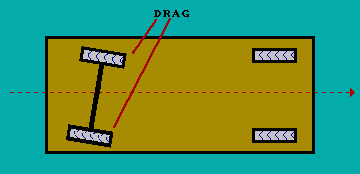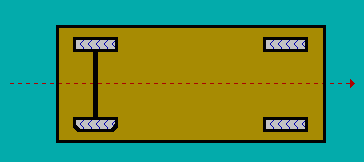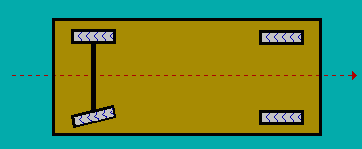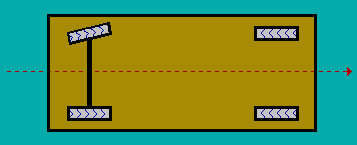FUEL ECONOMY AND REAR AXLE ALIGNMENT
- GOAL:
- 1. To understand that correct rear axle alignment is a factor in achieving optimum fuel economy.
- 2. To be aware that an incorrectly aligned rear axle will cause drag that results in lower fuel economy and increased wear on the rear tires.
- OBJECTIVES:
- The student will:
- 1. Learn to properly identify the need for rear axle alignment.
- 2. Recognize which vehicle types are most sensitive to misaligned rear axles.
- 3. Explain how a misaligned rear axle causes reduced fuel economy.
- LESSON/INFORMATION:
- A properly aligned front end has long been established as essential for long tire life, handling ease, and driving safety, as well as a factor in achieving optimum fuel economy. However, until recently, little attention has been focused on the alignment of the rear axle. A vehicle with a misaligned rear axle has reduced tire life, is more difficult to drive, may be unsafe, and delivers less than optimum fuel economy.
- Only in the last ten to twelve years have manufacturers and repair technicians paid attention to rear axle alignment. Prior to this time almost all vehicles were rear wheel drive and employed a dependent type suspension. These designs experience very little rear axle alignment change. Rear axle alignment was achieved by the very nature of the design and mount of the axle. Also, this axle design compensated for housing torque response. Until recently, only after a serious rear end collision was the rear axle and wheel alignment checked and re-aligned.
- A push for lighter, more fuel efficient vehicles resulted in the front wheel drive and an independent rear suspension automobile. These became the norm instead of the exception. Today, the vast majority of cars on the road are of the front wheel drive design and many also have independent rear suspensions. On front wheel drive vehicles, the rear wheels follow or trail the car and alignment becomes more critical. The rear axle of front wheel drive cars provide for camber and toe adjustments. Even vehicles with solid rear axles have these adjustments.
- All front wheel drive and any car with an independent rear suspension should have the rear axle alignment checked and adjusted any time the car pulls or any abnormal tire wear appears. These vehicles should have the rear axle alignment checked after any collision repair. This is especially true if the manufacturer used either unitized body, unitized body-stub frame, or monocoque construction. Minor shifts in the body and suspension mounts may cause significant shifts in both front and rear axle alignments. To align the front axle will only fix half the problem.
- A misaligned rear axle causes excessive tire-to-road drag and creates undesirable lateral forces. Figure 1 illustrates some possible rear axle alignment conditions and results. Note, these illustrations assume correct front axle alignment.
- Both of vehicle A's rear tires would exhibit feathered edges from left to right much as in an excessive toe condition. This vehicle would lead toward the right. The right rear tire of vehicle B would exhibit heavy outer shoulder wear. This vehicle would also lead toward the right. Vehicle C's right rear toe-in condition would feather wear this tire from the outer edge and cause the vehicle to lead toward the left. Vehicle D's left rear toe-out condition would feather wear this tire from the inside and cause the vehicle to lead toward the left. Each of these conditions will cause excessive tire drag, increased tire wear, and decreased fuel economy.
- Figure 1.

Vehicle A - Axle Lead

Vehicle B - Right Rear Tire Positive Chamber

Vehicle C - Right Rear Tire Toe-in

Vehicle D - Left Rear Tire Toe-out
- It is possible for a given car to have reciprocal rear axle misalignment conditions and not exhibit any poor driving characteristics. However, tires will still wear and fuel economy will be decreased.
- ACTIVITY:
- 1. Locate two front wheel drive cars, one with a solid axle and the other with independent suspension.
- 2. In the appropriate shop manual(s), locate the pre-alignment inspection sequence. Note any special procedures for rear axle alignment for each car.
- 3. From the shop manual(s) axle alignment specification section, determine the correct axle camber and toe settings.
- 4. From the shop manual(s), determine the correct adjustment procedures for camber and toe.
- 5. If 4 wheel alignment equipment is available, perform a four wheel alignment check on each car; make any necessary adjustment(s).
- 6. Summarize the rear axle alignment check and adjustment differences between car #1 and car #2.
- INFORMATION CHECK
- Directions: Indicate whether the statements below are true or false. If the statement is false, explain why it is false.
- 1. _______ The rear suspension on a front wheel drive car has either independent or solid rear axles; alignment adjustment is possible on both types.
- 2. _______ Even if the front wheels are aligned correctly, the car may still pull or lead to one side.
- 3. _______ A misaligned rear axle causes reduced fuel economy.
- 4. _______ Caster and toe are the two possible adjustments to be made on a rear axle.
- 5. _______ Heavy outer shoulder wear on a rear tire indicates possible excessive positive camber.
- TEACHER'S NOTES
- Recently the automotive service industry has focused on rear axle alignment. Some older technicians view this recent shift as a manufacturer's ploy to sell more equipment. Some consumers resist rear wheel adjustment due to additional costs. They see this as unnecessary since former cars did not need rear axle alignments. Part of this problem is a pricing structure that has evolved - charge the same price for "a check only" as to "check and adjust." For front wheel drive and all cars with independent rear suspensions, proper rear axle alignment is necessary for optimum fuel economy and tire wear. Proper rear axle alignment makes the car drive better. Significant out-of-specification (more than 2° camber and ¼" toe) rear axle alignment could be dangerous.
- ANSWERS TO INFORMATION CHECK:
- 1. True
- 2. True
- 3. True
- 4. False. Camber and toe are the rear axle adjustments. There is no caster setting for rear axles.
- 5. True
- RECOMMENDED READING:
- Birch, Thomas W., Automotive Suspension and Steering Systems. Pages 525-533.
- REFERENCES:
- Bacon, E. Miles. Principles of Wheel Alignment Service. McGraw Hill, Greg Division, New York, NY. 1985.
- Ellinger, Herbert E. and Richard B. Hathaway. Automotive Suspension and Steering Service. Prentice Hall, Englewood Cliffs, NJ. 1980.
- Birch, Thomas W. Automotive Suspension and Steering Systems. Harcourt Brace Jovanovich Technology Publications, San Diego, CA. 1987.
ACTIVITY SHEET
Name:___________________________ Date Completed:________________________
Car #1
- 1.
- Year __________________________
- Make __________________________
- Model __________________________
- Type of rear suspension:
- _______________________________
- 2. Pre-alignment checks:
- ______________________________
- ______________________________
- ______________________________
- 3. Rear axle alignment specifications:
- _______________________________
- _______________________________
- _______________________________
- 4. Adjustment procedures:
- Camber ________________________
- Toe ___________________________
- 5. Results of 4-wheel alignment check:
- Rear camber ___________________
- Rear toe ______________________
- Summary of findings:
- ______________________________________________________________________________
- ______________________________________________________________________________
- ______________________________________________________________________________
- ______________________________________________________________________________
- ______________________________________________________________________________
Car #2
- 1.
- Year __________________________
- Make __________________________
- Model __________________________
- Type of rear suspension:
- _______________________________
- 2. Pre-alignment checks:
- ______________________________
- ______________________________
- ______________________________
- 3. Rear axle alignment specifications:
- _______________________________
- _______________________________
- _______________________________
- 4. Adjustment procedures:
- Camber ________________________
- Toe ___________________________
- 5. Results of 4-wheel alignment check:
- Rear camber ___________________
- Rear toe ______________________
- Summary of findings:
- ______________________________________________________________________________
- ______________________________________________________________________________
- ______________________________________________________________________________
- ______________________________________________________________________________
- ______________________________________________________________________________
Comments or questions to: TechAsmt@LA.GOV
Return to Automotive Menu







